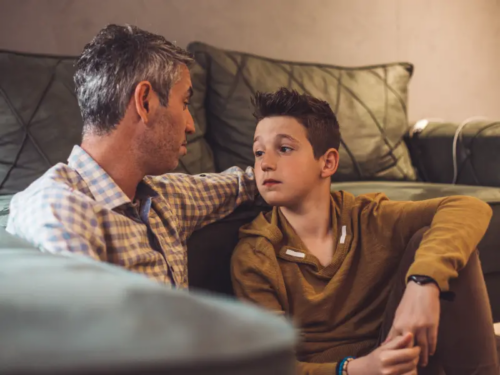
Table of Contents
Treatment-Resistant PTSD May Be Why Your PTSD Symptoms Won’t Improve

Written By: Ashley Laderer

Clinically Reviewed By: Dr. Don Gasparini
December 8, 2023
8 min.
If your PTSD symptoms won’t go away even with treatment, you might have treatment-resistant PTSD. Here’s what you need to know.
Learn more about our Clinical Review Process
Table of Contents
Living with post-traumatic stress disorder (PTSD) can be challenging. You may be faced with disturbing flashbacks, recurring nightmares, persistent low mood, and more. Certain memories, places, people, or situations can be extremely triggering and send you down a dark spiral. While PTSD is treatable, and many people find relief from their PTSD, other people can’t seem to shake their symptoms, even despite treatment. This is known as treatment-resistant PTSD. Read on to learn more about treatment-resistant PTSD, what causes it, and treatments that might finally bring you some much-needed relief.

Healing is possible
We specialize in trauma-informed virtual therapy for serious mental health conditions.
What is treatment-resistant PTSD?
“Treatment-resistant PTSD is loosely defined as PTSD that does not resolve after evidenced-based interventions have been administered over a prolonged period of time,” says Maggie Vitello, LCSW, Director of Crisis Prevention and Response at Charlie Health. The first-line evidence-based treatments for PTSD include psychotherapy (talk therapy) and psychiatric medications. In most cases, serotonin reuptake inhibitors (SSRIs) are usually the first choice of medications prescribed, though it does vary on a case-by-case basis.
So, even if someone with PTSD has been undergoing standard treatments such as therapy, medications, or even a combination of both, they may still grapple with severe, persistent symptoms if they are treatment-resistant. “When an individual presents with PTSD and has not had success in significantly reducing or resolving their symptoms after months, or possibly years, of treatment, we ask the following questions: is there more to the clinical picture?” Vitello says. In cases of treatment-resistant PTSD, it’s important to take a deeper look.
What are the signs and symptoms of treatment-resistant PTSD?
The Diagnostic and Statistical Manual of Mental Disorders, Fifth Edition (The DSM-5) outlines PTSD symptoms in multiple different categories. If you still experience many of these symptoms, and they are interfering with your quality of life and day-to-day functioning despite treatment, this is an indication that you could have treatment-resistant PTSD.
Intrusion symptoms
- Repeated distressing memories or nightmares of the traumatic event
- Flashbacks where you feel like the trauma is happening now
- May include emotional distress and physical symptoms (e.g., pain)
Avoidance symptoms
- Avoiding internal reminders (like thoughts or memories) of the trauma
- Avoiding external reminders (such as places, people, or situations) of the trauma
Cognitive/mood symptoms
- Difficulty remembering parts of the traumatic event
- Ongoing drastic negative beliefs about yourself or others
- Repeatedly blaming yourself or others for the trauma
- Losing interest in activities
- Feeling detached from other people
Arousal and reactivity symptoms
- Aggression, anger, and irritability
- Being reckless or self-destructive
- Hypervigilance
- Difficulty concentrating or sleeping
Also, some people with PTSD may have dissociative symptoms such as derealization or depersonalization. Derealization is when you feel like your surroundings aren’t real, and depersonalization is when you feel detached from yourself.
What are the potential causes of treatment-resistant PTSD?
Causes for treatment-resistant PTSD vary from person to person. However, various potential factors could contribute to treatment resistance, including:
The specific trauma that caused the PTSD
Whether the trauma resulting in the PTSD diagnosis was a single traumatic event, prolonged trauma, or multiple compounding traumas may play a role. “PTSD resulting from prolonged exposure to a traumatic stressor such as combat, and PTSD stemming from complex trauma such as chronic abuse, are shown to have poorer outcomes in general than PTSD stemming from a single event,” Vitello says.
Lack of social support
Social support plays a key role and is very influential in trauma recovery. This refers to social support earlier in life as well as after the trauma has occurred. “We know that having experiences of being cared for and supported by an attachment figure during stressful times throughout development sets the stage for greater psychological resilience and establishes resources to pull from during traumas later in life,” Vitello says. This means that if you’ve experienced trauma and haven’t had good social support, whether from attachment figures (like your caregivers), other family members, or friends, you may be more likely to experience poor treatment response.
Having co-occurring mental health conditions
Research shows that the vast majority of people with PTSD (80%) also have another mental health condition. This commonly includes anxiety disorders, depression, and substance use disorders. Unfortunately, comorbid mental health conditions can play a role in treatment resistance and overall treatment response. Managing multiple conditions at once can be complex, making it more challenging to reach major symptom relief.

Poor physical health
Some research has found that people with poorer physical health, such as people with overall poor health, chronic physical pain, injuries due to trauma, or sleep disorders, are more likely to have worse outcomes with treatment. This is because poor health could limit how one engages with therapy, or the health issues might play a role in worsening mental health in general.
Genetics
Biological factors, including genetics, often play a role in mental health conditions, and genetics may contribute to treatment resistance, too. Research surrounding treatment resistance has found that some genes may indicate or predict how well certain antidepressants work for any given individual. So, if antidepressants are a part of someone’s PTSD treatment plan and they don’t seem to be working, genetics could be part of the equation. Epigenetic factors like intergenerational trauma can also influence one’s stress response, says Vitello.
A person’s unique psychological makeup
Everyone has unique psychological traits. For example, some people are more resilient to stressors than others, or some have a more active stress response. Your unique psychological blueprint can determine if you develop certain mental health conditions and how you recover. “A person’s psychological makeup influences both the likelihood they will develop a full PTSD diagnosis after a major stressor and how they will recover from it,” says Vitello. “Psychological resilience can vary.”
What are the treatments for treatment-resistant PTSD?
Thankfully, there are many different ways to approach treatment-resistant PTSD, even if other types of therapy or medications have not worked in the past. A combination of different trauma-informed approaches may be especially helpful in cases of treatment-resistant PTSD. Some examples of treatment-resistant PTSD treatments are as follows.
Trauma-focused cognitive behavioral therapy (TF-CBT)
TF-CBT is a specific form of cognitive behavioral therapy (CBT) specially designed for trauma survivors. “TF-CBT can target symptoms of PTSD that have not been resolved with other methods of treatment by taking a three-pronged approach,” Vitello says. She says these three prongs are:
- Psychoeducation to enhance understanding and awareness of how trauma has impacted their functioning.
- Skill development to increase relaxation, affect modulation, and cognitive coping.
- Trauma narrative exposure work to desensitize the trauma response.
“Trauma processing alone without resourcing skills and social support can cause further re-triggering and prolong the recovery process, while skills-only interventions that neglect exposure work do not allow desensitization of trauma triggers,” she says. This is why TF-CBT can be so effective –– because it accounts for the whole picture, addressing all aspects of PTSD symptoms.
Cognitive processing therapy (CPT)
CPT focuses on the meaning and beliefs that survivors have internalized around their trauma to create healthier beliefs surrounding the trauma narrative. “CPT targets deeper mental constructs that may be keeping the person stuck in patterns of reenacting their trauma,” says Vitello. These mental constructs could include feeling responsible for the trauma or undeserving of recovery—and they’re often subconscious. “These deeply held beliefs may not be conscious and can restrict someone from trauma recovery until they are identified and resolved,” Vitello adds.
Prolonged exposure (PE) therapy
Often, trauma survivors avoid things that remind them of their trauma. However, avoidance fuels fear and can ultimately worsen PTSD symptoms in the long run. PE is a unique type of exposure therapy that helps survivors confront and process traumatic memories head-on rather than trying to avoid them. PE involves a structured, gradual approach to exposure. A trauma-informed therapist will encourage you to recount distressing memories, thoughts, and situations related to your trauma in a safe, controlled environment.
When you repeatedly expose yourself to these memories, you will experience a reduction in the overwhelming fear and anxiety associated with your traumatic experience or experiences. Exposures may be “imaginal,” meaning in your imagination, remembering and telling your therapist the details of your traumatic incident, or “in vivo,” meaning confronting certain fears outside of the sessions. Your therapist will help determine what type of exposures will be safe and beneficial for you. If you’ve tried other types of therapy but still engage in avoidance, this PTSD treatment can be a game-changer for treatment resistance.
Eye movement desensitization and reprocessing (EMDR)
EMDR is very different from typical talk therapy. It was developed specifically as a PTSD treatment and commonly uses bilateral (side-to-side) eye movements to help you process emotionally charged, triggering memories. Other types of bilateral stimulation may also be used, such as sound or touch. A qualified, trauma-informed EMDR therapist will ask you to remember your traumatic memories while following their hand, moving side to side with your eyes. This can help you process trauma more quickly, storing the memories differently in your brain while making them evoke less distressing visceral reactions.

Somatic interventions
You may have heard that trauma is stored in the body. Somatic therapies are a way to target this by releasing trauma from the body through mindfulness and movement. “Trauma can over-activate the body’s stress response, putting survivors in a perpetual state of being on guard,” says Vitello. “Coupling psychoeducation and process-oriented therapies with somatic interventions often provides greater relief by rewiring neural pathways, allowing the brain and body to understand they are no longer under attack.”
Alternative treatments
When traditional PTSD treatments like SSRI medications have failed, it is possible to look into other medications. In recent years, clinical psychiatry trials have shown promising results addressing PTSD with ketamine treatment and MDMA therapy. Ketamine treatment includes ketamine infusion therapy, ketamine-assisted psychotherapy, or esketamine nasal spray. Ketamine infusion therapy, among the most commonly used in clinical settings, has shown promise in addressing PTSD. While the data from clinical trials is promising, more research is needed to determine long-term safety and efficacy.
Intensive therapy programs
Some people find PTSD symptom relief from once-weekly therapy, but those struggling with more severe mental health conditions, including treatment-resistant PTSD, may benefit from a more intensive option. These intensive options range from intensive outpatient programs (IOP) and partial hospitalization programs (PHP) to 24/7 care options like inpatient programs. Intensive therapy programs can be beneficial for treatment-resistant PTSD because they often combine multiple kinds of therapies and focus on group therapy, says Vitello. “Charlie Health’s IOP centers on group treatment, which allows clients to share and process at their pace while witnessing their peers’ successes, which reduces isolation, guilt, and shame,” she adds.
How Charlie Health can help with treatment-resistant PTSD
If you’re grappling with post-traumatic stress disorder and not finding symptom relief, Charlie Health is here to help. Charlie Health’s virtual Intensive Outpatient Program (IOP) provides more than once-weekly mental health treatment for teens and adults dealing with serious mental health conditions, including treatment-resistant PTSD. Our expert clinicians incorporate a variety of evidence-based, trauma-informed therapies into individual counseling, family therapy, and group sessions. Fill out the form below or give us a call to start healing today.
References
https://www.ncbi.nlm.nih.gov/books/NBK207191/box/part1_ch3.box16/
https://academic.oup.com/ijnp/article/22/2/93/4980962?login=false
https://www.ncbi.nlm.nih.gov/pmc/articles/PMC4287702/
https://www.ncbi.nlm.nih.gov/pmc/articles/PMC7748158/
https://www.apa.org/ptsd-guideline/treatments/cognitive-processing-therapy
https://www.apa.org/ptsd-guideline/treatments/prolonged-exposure
https://www.apa.org/ptsd-guideline/treatments/eye-movement-reprocessing




